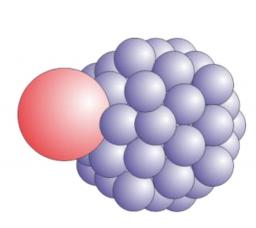Headlines 2014
|
One of the goals in physical chemistry is to follow reaction paths in details. Many techniques have been developed with studies conducted in cells, effusive or supersonic beams, using laser spectroscopy, mass spectrometry etc. as investigation tools.
An original technique called "Cluster Isolated Chemical Reaction" (CICR) has been developed by the group "Dynamique Réactionnelle" of LIDyL/LFP for spectroscopic and reaction dynamics studies [1]. It allows determining the stoichiometry of the observed processes on a nanoreactor consisting of a van der Waals cluster. Recently, it has been successfully applied to helium droplet, which is a quite fascinating medium joining a very low temperature (0.37 K), superfluidity and finite size. The latter allows trapping and isolating a controlled number of molecules and stabilizing complexes which have a very low stability. The study of such systems provides very accurate information on the intramolecular potential energy surfaces (PES), improving the reliability of the associated models. |
|
One of the goals in physical chemistry is to follow reaction paths in details. Many techniques have been developed with studies conducted in cells, effusive or supersonic beams, using laser spectroscopy, mass spectrometry etc. as investigation tools.
An original technique called "Cluster Isolated Chemical Reaction" (CICR) has been developed by the group "Dynamique Réactionnelle" of LIDyL/LFP for spectroscopic and reaction dynamics studies [1]. It allows determining the stoichiometry of the observed processes on a nanoreactor consisting of a van der Waals cluster. Recently, it has been successfully applied to helium droplet, which is a quite fascinating medium joining a very low temperature (0.37 K), superfluidity and finite size. The latter allows trapping and isolating a controlled number of molecules and stabilizing complexes which have a very low stability. The study of such systems provides very accurate information on the intramolecular potential energy surfaces (PES), improving the reliability of the associated models. |











